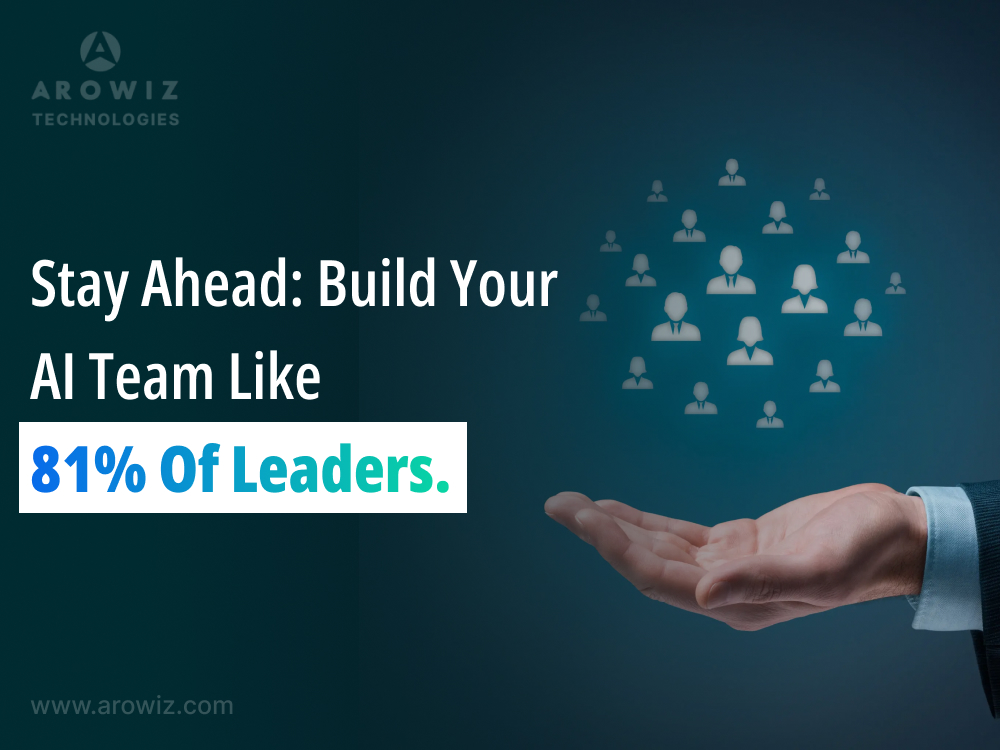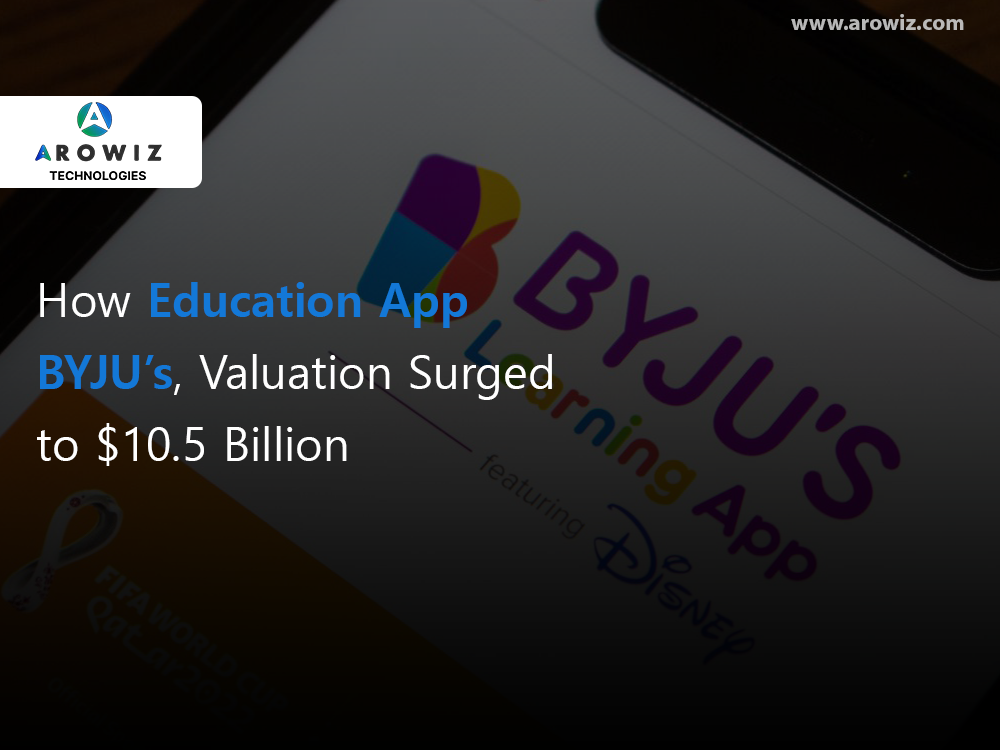In today’s dynamic business landscape, where innovation is the key to survival and growth, staying ahead of the curve is…
Stay Ahead: Build Your AI Team Like 81% of Leaders
admin
- June 9, 2024
7 min read

In today’s dynamic business landscape, where innovation is the key to survival and growth, staying ahead of the curve is essential. One of the most powerful tools available for businesses to achieve this is generative AI.
Generative AI refers to artificial intelligence systems capable of creating new content autonomously, such as images, text, or music, that closely resembles content produced by humans.

This blog will delve deeper into the concept of generative AI, its significance, various types, features, benefits, utilization cases, technologies involved, the future outlook, and how Arowiz Technologies can assist businesses in leveraging this technology.
What is Generative AI and Why is it Needed?
Generative AI represents a significant leap forward in AI technology, enabling machines to not only understand but also create content. This capability is crucial for businesses across industries as it opens up avenues for automation, innovation, and efficiency.
Supercharge your startup with our FREE MVP Guide E-Book
Download it now to kickstart your growth and turn your ideas into reality.

With generative AI, businesses can automate repetitive tasks, generate personalized content at scale, and unlock new possibilities for creativity and innovation.
Why is Generative AI Useful?
Generative AI offers several advantages for businesses, including increased productivity, cost savings, enhanced creativity, and improved decision-making. By automating tasks that would otherwise require significant time and resources, businesses can streamline their operations and focus on more strategic activities. Moreover, generative AI can generate content tailored to specific audiences, leading to more engaging and personalized experiences for customers.
Types of Generative AI:

- Text Generation: Text generation models, like GPT (Generative Pre-trained Transformer) models, are capable of producing coherent and contextually relevant text. They can generate anything from short stories to news articles to poetry.
- Image Generation: Image generation models, such as Generative Adversarial Networks (GANs), can create new images based on patterns learned from existing datasets. These models are often used in art generation, image editing, and data augmentation.
- Music Generation: Music generation AI can compose original pieces of music in various styles and genres. These models often use recurrent neural networks (RNNs) or transformer architectures to learn musical patterns and structures.
- Video Generation: Video generation AI can create new video content, such as deepfake videos, synthetic training data for computer vision models, or even entirely computer-generated animations.
- Speech Generation: Speech generation models can synthesize human-like speech from text input. These models are often used in virtual assistants, audiobook narration, and accessibility applications.
- 3D Object Generation: 3D object generation AI can create three-dimensional models of objects based on input parameters or existing examples. These models are used in fields like computer-aided design (CAD), virtual reality (VR), and gaming.
Features of Generative AI:
- Flexibility: Generative AI models are flexible in generating diverse outputs across different domains. They can adapt to various input conditions and produce outputs that exhibit creativity and novelty.
- Scalability: Generative AI models can scale to handle large datasets and complex tasks. They can generate vast amounts of content efficiently, making them suitable for applications such as content creation, data augmentation, and artistic expression.
- Adaptability: Generative AI models can adapt to different styles, preferences, or constraints specified by users or specific tasks. They can learn from feedback and improve their output quality over time, enhancing their usefulness in various applications.
- Interpretability: Some generative AI models offer interpretability features that allow users to understand how the model generates outputs. This transparency helps users trust the model’s decisions and identify areas for improvement or customization.
- Controllability: Generative AI models often provide mechanisms for users to control the generated outputs. Users can manipulate input parameters, guide the generation process, or impose constraints to steer the outputs toward desired outcomes, enabling customization and personalization.
- Ethical Considerations: Generative AI raises ethical considerations related to the potential misuse of generated content, such as deepfake videos or fake news articles. Developers and users must consider the ethical implications of using generative AI responsibly and mitigate risks associated with misinformation and manipulation.
Benefits of Generative AI:

- Creativity Augmentation: Generative AI enhances human creativity by providing tools and platforms for generating novel and imaginative content. It can inspire artists, writers, designers, and other creative professionals by generating new ideas, designs, and compositions.
- Data Augmentation: Generative AI can augment datasets by creating synthetic data that supplements real-world observations. This is particularly useful in scenarios where collecting large amounts of labeled data is challenging or expensive, such as in medical imaging, autonomous driving, or rare event detection.
- Personalization: Generative AI enables personalized experiences by generating content tailored to individual preferences, interests, or characteristics. This can improve user engagement, satisfaction, and retention in applications such as recommendation systems, personalized marketing, and adaptive user interfaces.
- Automation: Generative AI automates content creation processes, reducing the time and effort required to generate high-quality content. It can generate text, images, music, and other media at scale, streamlining workflows and freeing up human resources for more creative or strategic tasks.
- Exploration of Possibilities: Generative AI facilitates the exploration of vast solution spaces and the discovery of new possibilities in design, optimization, and problem-solving. It can generate diverse alternatives, explore design trade-offs, and uncover unexpected solutions that may not be immediately apparent to human designers or engineers.
- Research Advancement: Generative AI drives research advancements in AI and related fields by pushing the boundaries of what AI systems can achieve. It fosters innovation in machine learning algorithms, architectures, and applications, leading to breakthroughs in areas such as natural language processing, computer vision, and reinforcement learning.
Utilization Cases of Generative AI:

- Content Creation: Generative AI assists in generating diverse content such as news articles, scripts, artwork, and designs, streamlining creative processes across various industries.
- Design and Creativity: Generative AI aids designers by generating alternative designs, patterns, and styles, facilitating creative exploration in fields like fashion, architecture, and graphic design.
- Personalized Recommendations: Generative AI powers recommendation systems that offer personalized suggestions for products, media, and content based on user preferences and behavior.
- Healthcare Imaging and Diagnosis: Generative AI is used in healthcare for tasks such as generating synthetic medical images, enhancing image quality, and reconstructing images for diagnosis and research purposes.
- Virtual Assistants and Conversational Agents: Generative AI enables virtual assistants and chatbots to interact with users through natural language processing, providing assistance and engaging in conversations across platforms.
- Artistic Expression and Generative Art: Generative AI serves as a tool for artistic expression, allowing artists to explore new creative possibilities and generate original artworks, music, and multimedia experiences.
Supercharge your startup with our FREE MVP Guide E-Book
Download it now to kickstart your growth and turn your ideas into reality.
Technologies Involved in Generative AI:
Generative AI relies on advanced technologies such as natural language processing (NLP), deep learning, neural networks, reinforcement learning, computer vision, and generative adversarial networks (GANs). These technologies form the foundation of generative AI systems and enable them to generate high-quality content autonomously.
The Future of Generative AI:
The future of generative AI is promising, with potential applications in entertainment, education, healthcare, and beyond.

As AI technology continues to evolve, generative AI is expected to play an increasingly important role in driving innovation and shaping the future of various industries.
How Can Arowiz Technologies Help With?
Arowiz Technologies specializes in developing custom generative AI solutions tailored to the specific needs of businesses. By partnering with Arowiz Technologies, businesses can access expertise and resources to build and deploy generative AI solutions effectively.
FAQ:
Q: What is a generative AI team?
A: A generative AI team consists of professionals who specialize in developing and implementing artificial intelligence algorithms and models that can generate new content, ideas, or solutions autonomously.
Q: Why should I establish a generative AI team?
A: With the rapid advancement of AI technology, businesses need to stay ahead by leveraging generative AI to automate tasks, create innovative solutions, and gain competitive advantages.
Q: What roles should be included in a generative AI team?
A: A typical generative AI team may include roles such as AI researchers, data scientists, machine learning engineers, software developers, domain experts, and project managers.
Q: How do I build a generative AI team?
A: Start by identifying your organization’s specific needs and goals related to generative AI. Then, recruit professionals with relevant skills and expertise in AI, data science, and related fields. Provide training and resources to foster collaboration and innovation within the team.
Q: What skills are essential for generative AI team members?
A: Essential skills include proficiency in programming languages (such as Python), expertise in machine learning and deep learning algorithms, knowledge of data preprocessing and analysis techniques, and experience with relevant tools and frameworks (e.g., TensorFlow, PyTorch).
Q: How can I ensure the success of my generative AI team?
A: Foster a culture of continuous learning and experimentation, provide access to cutting-edge technologies and resources, encourage interdisciplinary collaboration, and establish clear goals and metrics for measuring success.
Conclusion:
Generative AI represents a transformative technology that has the potential to revolutionize how businesses operate and innovate. By embracing generative AI and partnering with experts like Arowiz Technologies, businesses can unlock new opportunities for growth, differentiation, and success in an increasingly competitive marketplace.
Pro Tip: Regularly updating generative AI models with new data ensures optimal performance and relevance, maximizing the value derived from AI-driven innovation.
Tags
- aiEnsuring
Our New Letter
Get productivity tips delivered straight to your inbox
Ready for more?

Arowiz Technologies is a Central India-based customer Centric software development & Expert IT Staff Augmentation company ...
FOR JOBS
hr@arowiz.comFOR SALES
sales@arowiz.comMARKETING / BLOGS
info@arowiz.comGET CONNECTED
Top Industry
About Us
Top Services
Hire Expert Developers
- AI / ML Developers
- Blockchain Developers
- DevOps Developers
- Web3 / Gaming Developers
- Full Stack Developers
- AR / VR – Meta Developers
- Python Developers
- Solidity Developers
- Node.js Developers
- ReatJs Developers
- Next.Js Developers
- Flutter Developers
- React Native Developers
- Golang Developers
- Mobile App Developers








